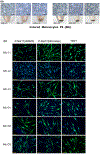Induced pluripotent stem cells reprogramming overcomes technical limitations for highly pigmented adult melanocyte amplification and integration in 3D skin model
- PMID: 36478412
- PMCID: PMC10731472
- DOI: 10.1111/pcmr.13077
Induced pluripotent stem cells reprogramming overcomes technical limitations for highly pigmented adult melanocyte amplification and integration in 3D skin model
Abstract
Understanding pigmentation regulations taking into account the original skin color type is important to address pigmentary disorders. Biological models including adult melanocytes from different phenotypes allow to perform fine-tuned explorative studies and support discovery of treatments adapted to populations' skin color. However, technical challenges arise when trying to not only isolate but also amplify melanocytes from highly pigmented adult skin. To bypass the initial isolation and growth of cutaneous melanocytes, we harvested and expanded fibroblasts from light and dark skin donors and reprogrammed them into iPSC, which were then differentiated into melanocytes. The resulting melanocyte populations displayed high purity, genomic stability, and strong proliferative capacity, the latter being a critical parameter for dark skin cells. The iPSC-derived melanocyte strains expressed lineage-specific markers and could be successfully integrated into reconstructed skin equivalent models, revealing pigmentation status according to the native phenotype. In both monolayer cultures and 3D skin models, the induced melanocytes demonstrated responsiveness to promelanogenic stimuli. The data demonstrate that the iPSC-derived melanocytes with high proliferative capacity maintain their pigmentation genotype and phenotypic properties up to a proper integration into 3D skin equivalents, even for highly pigmented cells.
Keywords: induced pluripotent stem cells; lineage specification; melanocyte pigmentation; reconstructed skin model; skin color.
© 2022 The Authors. Pigment Cell & Melanoma Research published by John Wiley & Sons Ltd.
Figures







Similar articles
-
Human skin model containing melanocytes: essential role of keratinocyte growth factor for constitutive pigmentation-functional response to α-melanocyte stimulating hormone and forskolin.Tissue Eng Part C Methods. 2012 Dec;18(12):947-57. doi: 10.1089/ten.TEC.2011.0676. Epub 2012 Jul 2. Tissue Eng Part C Methods. 2012. PMID: 22646688
-
Melanin Transfer in Human 3D Skin Equivalents Generated Exclusively from Induced Pluripotent Stem Cells.PLoS One. 2015 Aug 26;10(8):e0136713. doi: 10.1371/journal.pone.0136713. eCollection 2015. PLoS One. 2015. PMID: 26308443 Free PMC article.
-
Modeling neural crest induction, melanocyte specification, and disease-related pigmentation defects in hESCs and patient-specific iPSCs.Cell Rep. 2013 Apr 25;3(4):1140-52. doi: 10.1016/j.celrep.2013.03.025. Epub 2013 Apr 11. Cell Rep. 2013. PMID: 23583175 Free PMC article.
-
Melanocyte stem cells as potential therapeutics in skin disorders.Expert Opin Biol Ther. 2014 Nov;14(11):1569-79. doi: 10.1517/14712598.2014.935331. Epub 2014 Aug 8. Expert Opin Biol Ther. 2014. PMID: 25104310 Free PMC article. Review.
-
[Phenotypic plasticity of neural crest-derived melanocytes and Schwann cells].Biol Aujourdhui. 2011;205(1):53-61. doi: 10.1051/jbio/2011008. Epub 2011 Apr 19. Biol Aujourdhui. 2011. PMID: 21501576 Review. French.
Cited by
-
Implementing differentially pigmented skin models for predicting drug response variability across human ancestries.Hum Genomics. 2024 Oct 9;18(1):113. doi: 10.1186/s40246-024-00677-7. Hum Genomics. 2024. PMID: 39385300 Free PMC article. Review.
-
Significance of melanin distribution in the epidermis for the protective effect against UV light.Sci Rep. 2024 Feb 12;14(1):3488. doi: 10.1038/s41598-024-53941-0. Sci Rep. 2024. PMID: 38347037 Free PMC article.
References
-
- Boyce ST, Lloyd CM, Kleiner MC, Swope VB, Abdel-Malek Z, & Supp DM (2017). Restoration of cutaneous pigmentation by transplantation to mice of isogeneic human melanocytes in dermal-epidermal engineered skin substitutes. Pigment Cell & Melanoma Research, 30(6), 531–540. 10.1111/pcmr.12609 - DOI - PubMed
Publication types
MeSH terms
Grants and funding
LinkOut - more resources
Full Text Sources

